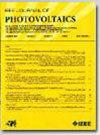商用TOPCon光伏组件加速老化试验比较
IF 2.6
3区 工程技术
Q3 ENERGY & FUELS
引用次数: 0
摘要
尽管存在可靠性问题,但隧道氧化物钝化触点(TOPCon)将成为新的主流电池技术。这项工作比较了来自五个不同制造商的商用TOPCon光伏(PV)模块类型的各种电气特性和加速老化测试。本案例研究代表了大型光伏装置的光伏模块选择过程。因此,这项工作的特点是对电气性能(能量等级)进行深入比较,可以作为最先进的TOPCon模块的参考。老化结果证实了之前报道的TOPCon技术由于湿度进入而降解的机制。在紫外线老化的情况下,出现了一种新的强烈降解模式(在60千瓦时/平方米后高达-12%),并在湿度冻结测试后随后恢复,这可能会影响认证测试的结果(IEC61730-2,序列B)。尽管与TOPCon电池技术没有直接联系,但机械负载测试揭示了几种模块类型的弱点,与模块尺寸、框架高度和玻璃性能有关。在此基础上,强调了进行更集中的测试和技术开发的必要性。本文章由计算机程序翻译,如有差异,请以英文原文为准。
Comparison of Commercial TOPCon PV Modules in Accelerated Aging Tests
Tunnel oxide passivated contact (TOPCon) is set to become the new mainstream cell technology despite pending reliability concerns. This work compares commercially available TOPCon photovoltaic (PV) module types from five different manufacturers in a variety of electrical characterization and accelerated aging tests. This case study represents a selection process of PV modules for larger PV installations. Therefore, the work features an in-depth comparison of the electrical performance (energy rating) that can serve as a reference for state-of-the-art TOPCon modules. The aging results confirm previously reported degradation mechanisms of the TOPCon technology due to humidity ingress. In the case of UV aging, a new pattern of strong degradation (up to –12% after 60 kWh/m
2
;) and subsequent recovery after humidity freeze test is presented, which could have implications on the results of certification tests (IEC61730-2, Sequence B). Though not directly connected to the TOPCon cell technology, the mechanical load tests revealed weaknesses of several module types, related to module dimensions, frame height, and glass properties. Based on the results, the necessity for more focused testing and technological development is highlighted.
求助全文
通过发布文献求助,成功后即可免费获取论文全文。
去求助
来源期刊

IEEE Journal of Photovoltaics
ENERGY & FUELS-MATERIALS SCIENCE, MULTIDISCIPLINARY
CiteScore
7.00
自引率
10.00%
发文量
206
期刊介绍:
The IEEE Journal of Photovoltaics is a peer-reviewed, archival publication reporting original and significant research results that advance the field of photovoltaics (PV). The PV field is diverse in its science base ranging from semiconductor and PV device physics to optics and the materials sciences. The journal publishes articles that connect this science base to PV science and technology. The intent is to publish original research results that are of primary interest to the photovoltaic specialist. The scope of the IEEE J. Photovoltaics incorporates: fundamentals and new concepts of PV conversion, including those based on nanostructured materials, low-dimensional physics, multiple charge generation, up/down converters, thermophotovoltaics, hot-carrier effects, plasmonics, metamorphic materials, luminescent concentrators, and rectennas; Si-based PV, including new cell designs, crystalline and non-crystalline Si, passivation, characterization and Si crystal growth; polycrystalline, amorphous and crystalline thin-film solar cell materials, including PV structures and solar cells based on II-VI, chalcopyrite, Si and other thin film absorbers; III-V PV materials, heterostructures, multijunction devices and concentrator PV; optics for light trapping, reflection control and concentration; organic PV including polymer, hybrid and dye sensitized solar cells; space PV including cell materials and PV devices, defects and reliability, environmental effects and protective materials; PV modeling and characterization methods; and other aspects of PV, including modules, power conditioning, inverters, balance-of-systems components, monitoring, analyses and simulations, and supporting PV module standards and measurements. Tutorial and review papers on these subjects are also published and occasionally special issues are published to treat particular areas in more depth and breadth.
 求助内容:
求助内容: 应助结果提醒方式:
应助结果提醒方式:


